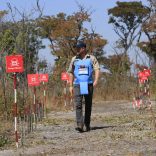Portugal's TAP sees strong growth potential in Brazil, Africa
CPLP: Synthetic drug consumption increasing rapidly – executive secretary

FILE - For illustration purposes only. [File photo: Lusa]
The consumption of synthetic drugs is increasing sharply and may surpass the consumption of drugs of plant origin, the executive secretary of the CPLP, Zacarias da Costa, said on Tuesday at the presentation of an annual report on narcotics.
The consumption of “synthetic drugs is increasing very sharply” and could “take the place of some drugs of plant origin”, and “there has been a very significant increase in the number of deaths resulting from the consumption of these substances, with a very negative impact on public health”, declared Zacarias da Costa at the online presentation of the first chapter of the report of the International Narcotics Control Board (INCB) 2024, presented for the first time in Portuguese and in partnership with the Community of Portuguese Language Countries (CPLP).
“For us, the CPLP, it is an honour to be associated with the presentation of the 2024 INCB report, an event taking place for the first time in Portuguese,” he said.
According to Zacarias da Costa, based on the JIFE 2024 report, the synthetic drugs industry is evolving very quickly due to its characteristics: for example, it doesn’t need land for cultivation and the facilities or laboratories can be mobile.
The JIFE representative who presented the report, Mariângela Simão, added that the increase in the manufacture of synthetic substances is due to reduced operating costs, geographical flexibility, globalisation, greater resilience against seizures, new compounds created by changes in the molecular structure of substances, the adoption of new methods, low costs and high profits, and the fact that drug consignments are increasingly smaller in size (they are lighter than plant drugs).
According to the study, synthetic drugs can be much more potent than drugs of plant origin and cause hundreds of thousands of overdose deaths every year.
Concerning Africa, “trafficking to markets in the south, east and west has been steadily increasing,” explained Mariângela Simão.
According to the report, there is large-scale drug trafficking on the African continent, visible “by the significant seizures of cocaine and other drugs in the Sahel”.
Africa has increased its consumption of cocaine, “probably a side effect of the continent’s use as a transit region for cocaine trafficking to Europe”, but the data remains scarce.
Meanwhile, the use of “kush” – a mixture of drugs that can contain various psychoactive substances – remains a concern in West Africa, she emphasised.
Several African countries have introduced measures to prioritise prevention and treatment programmes over punitive measures.
However, the number of people receiving treatment for drug use disorders in Africa remains very low, Mariângela Simão lamented.
According to the research, Africa remains a region of particular concern in terms of the availability of narcotics and psychotropic substances, such as synthetic pharmaceutical drugs falsified for medical and scientific purposes.
One of the examples cited in the presentation by the JIFE representative is the use of the tramadol.
Mariângela Simão cited tools and initiatives, such as international drug control conventions and the JIFE GRIDS Programme, that can help control this trafficking.
She also indicated public policies for combating this trafficking, such as national coordination, law enforcement, information sharing and public-private partnerships.
According to its website, JIFE is an independent monitoring body implementing the United Nations International Drug Control Conventions. According to information on its website, it was established in 1968 under the 1961 Drug Convention.
The CPLP, founded in 1996, comprises Angola, Brazil, Cabo Verde, Guinea-Bissau, Equatorial Guinea, Portugal, Mozambique, Sao Tome and Principe and Timor-Leste.












Leave a Reply
Be the First to Comment!
You must be logged in to post a comment.
You must be logged in to post a comment.